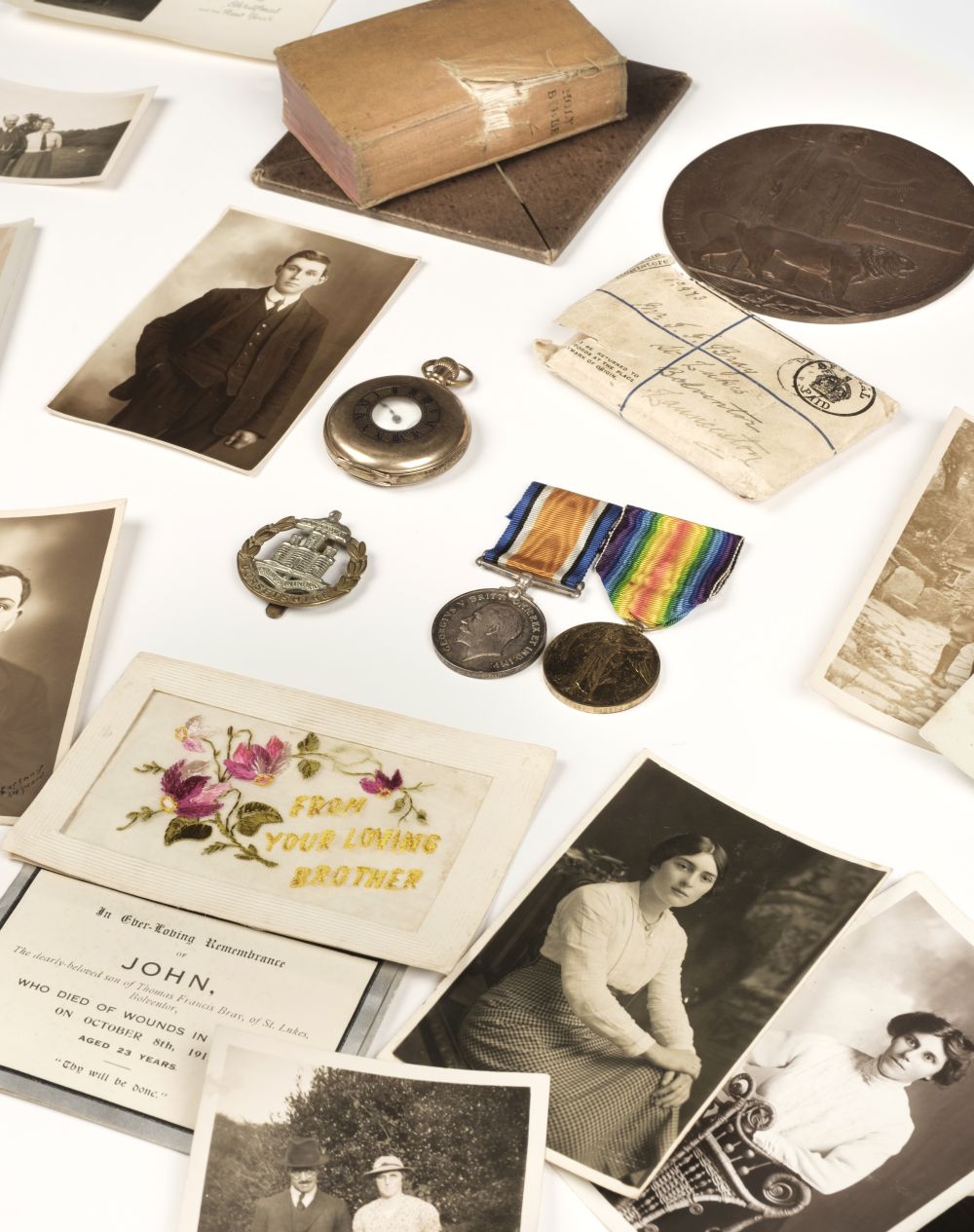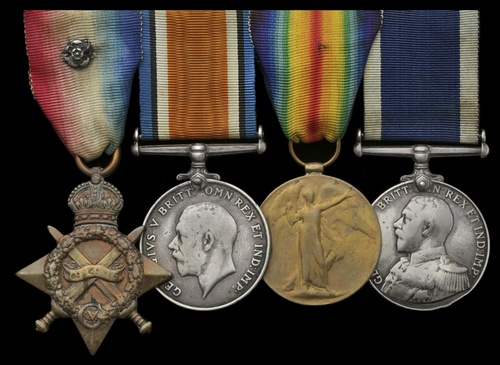An emotive Great War campaign and Belgian Civil Decoration group of four awarded to Flying Officer M. H. Steff, Royal Air Force, late Royal Navy and Royal Naval Air Service, who was Second Officer of the R. 101 and Officer of the Watch at the time of her tragic loss over France in October 1930 1914-15 Star (M. 8534 M. H. Steff, 3 Wtr., R.N.); British War and Victory Medals (2/Lieut. M. H. Steff, R.A.F.); Belgium, Civic Decoration, 2nd Class, silver and enamel, crude repairs in places to the enamel on the latter, otherwise good very fine together with: Aero Club Royal De Belgique presentation medallion, in bronze, for ‘11e Coupe Gordon Bennett Anvers 1926’, the reverse inscribed, ‘Flying Off. M. H. Steff’, 45mm. by 66mm. British Colony at Antwerp presentation medallion, in bronze, for ‘The Gordon Bennett Cup, May 30th 1926’, the reverse inscribed, ‘Flying Officer M. H. Steff’, 56mm. by 65mm., extremely fine (6) £5000-6000 Footnote Maurice Henry Steff, who was born in Luton, Bedfordshire, in March 1896, entered the Royal Navy as a Writer and Coder in September 1914. Subsequently present at the battle of Jutland in H.M.S. Inflexible, he transferred to the Royal Naval Air Service’s Kite Balloon Section in the rank of Flight Officer in January 1918, in which capacity he served in the Adriatic Barrage. Having then participated in minesweeping operations in the Aegean, Dardanelles and Black Sea in 1919, he was posted to the Staff of the R.A.F’s Balloon Training School back in England, and, as an accomplished “balloonatic”, participated in the Gordon Bennett Cup in Belgium in May 1926, representing Great Britain in the balloon Bee. Indeed it was on the back of such experience that he was subsequently posted to Royal Airship Works at Cardington in September 1928, the commencement of two years employment as an airship officer in the R. 100 and R. 101 projects. Thus his important part in the maiden and trial flights of both airships and, in fact, the R. 100’s epic return flight to Canada, when, for the first time, he acted as Second Officer. So, too, as Officer of the Watch in the control car, with a team of two Coxswains, seven Engineers, four Riggers and a W./T. Operator under his direct command. And it was in that capacity that he effectively took command of the R. 101 at 2 a.m. on 5 October 1930, just eight minutes before disaster struck over Beauvais on her ill-fated flight to India. The R. 101 disaster needs little introduction here, attracting as it did a mass of world wide media coverage at the time and much published material since - the airship’s roll honour listed no less than 48 names, among them a host of experienced airship pioneers like Steff, and Brigadier-General Lord Thomson, C.B.E., D.S.O., the Secretary of State for Air. But to put the project in perspective, it was back in 1924 that the British Government had decided to build two modern rigid airships with a view to starting an airline with a preliminary route being London-India and eventually London-Australia. Constructed at the Royal Airship Works at Cardington in Bedfordshire, the R. 101 found herself under growing competition from airship R. 100, the latter being privately funded and being constructed by Vickers. However, after much political wrangling over her size and engines, R. 101 completed her first test flight in October 1929, though she was found to be lacking in several fundamental areas, not least the fact she weighed some 23 tons more than originally intended, as a result of her complex design; so, too, the added concern of a reduction in lift. Accordingly it was argued that the programme should be scrapped, but the incumbent Labour Government had already invested a fortune in the project and was reluctant to back down. Modifications were therefore carried out, including the scrapping of a particularly costly power steering unit, while Lord Thomson, the Secretary of State for Air, pressed for a maiden flight to India - his intention being for a triump
An emotive Great War campaign and Belgian Civil Decoration group of four awarded to Flying Officer M. H. Steff, Royal Air Force, late Royal Navy and Royal Naval Air Service, who was Second Officer of the R. 101 and Officer of the Watch at the time of her tragic loss over France in October 1930 1914-15 Star (M. 8534 M. H. Steff, 3 Wtr., R.N.); British War and Victory Medals (2/Lieut. M. H. Steff, R.A.F.); Belgium, Civic Decoration, 2nd Class, silver and enamel, crude repairs in places to the enamel on the latter, otherwise good very fine together with: Aero Club Royal De Belgique presentation medallion, in bronze, for ‘11e Coupe Gordon Bennett Anvers 1926’, the reverse inscribed, ‘Flying Off. M. H. Steff’, 45mm. by 66mm. British Colony at Antwerp presentation medallion, in bronze, for ‘The Gordon Bennett Cup, May 30th 1926’, the reverse inscribed, ‘Flying Officer M. H. Steff’, 56mm. by 65mm., extremely fine (6) £5000-6000 Footnote Maurice Henry Steff, who was born in Luton, Bedfordshire, in March 1896, entered the Royal Navy as a Writer and Coder in September 1914. Subsequently present at the battle of Jutland in H.M.S. Inflexible, he transferred to the Royal Naval Air Service’s Kite Balloon Section in the rank of Flight Officer in January 1918, in which capacity he served in the Adriatic Barrage. Having then participated in minesweeping operations in the Aegean, Dardanelles and Black Sea in 1919, he was posted to the Staff of the R.A.F’s Balloon Training School back in England, and, as an accomplished “balloonatic”, participated in the Gordon Bennett Cup in Belgium in May 1926, representing Great Britain in the balloon Bee. Indeed it was on the back of such experience that he was subsequently posted to Royal Airship Works at Cardington in September 1928, the commencement of two years employment as an airship officer in the R. 100 and R. 101 projects. Thus his important part in the maiden and trial flights of both airships and, in fact, the R. 100’s epic return flight to Canada, when, for the first time, he acted as Second Officer. So, too, as Officer of the Watch in the control car, with a team of two Coxswains, seven Engineers, four Riggers and a W./T. Operator under his direct command. And it was in that capacity that he effectively took command of the R. 101 at 2 a.m. on 5 October 1930, just eight minutes before disaster struck over Beauvais on her ill-fated flight to India. The R. 101 disaster needs little introduction here, attracting as it did a mass of world wide media coverage at the time and much published material since - the airship’s roll honour listed no less than 48 names, among them a host of experienced airship pioneers like Steff, and Brigadier-General Lord Thomson, C.B.E., D.S.O., the Secretary of State for Air. But to put the project in perspective, it was back in 1924 that the British Government had decided to build two modern rigid airships with a view to starting an airline with a preliminary route being London-India and eventually London-Australia. Constructed at the Royal Airship Works at Cardington in Bedfordshire, the R. 101 found herself under growing competition from airship R. 100, the latter being privately funded and being constructed by Vickers. However, after much political wrangling over her size and engines, R. 101 completed her first test flight in October 1929, though she was found to be lacking in several fundamental areas, not least the fact she weighed some 23 tons more than originally intended, as a result of her complex design; so, too, the added concern of a reduction in lift. Accordingly it was argued that the programme should be scrapped, but the incumbent Labour Government had already invested a fortune in the project and was reluctant to back down. Modifications were therefore carried out, including the scrapping of a particularly costly power steering unit, while Lord Thomson, the Secretary of State for Air, pressed for a maiden flight to India - his intention being for a triump



/50170/Internet%20Image%204.jpg)


/111486/Internet%20Image%201.jpg)
/96362/Internet%20Image%201.jpg)



/41077/Internet%20Image%201.jpg)
/36297/Internet%20Image%201.jpg)

/44896/Internet%20Image%201.jpg)
Try LotSearch and its premium features for 7 days - without any costs!
Be notified automatically about new items in upcoming auctions.
Create an alert